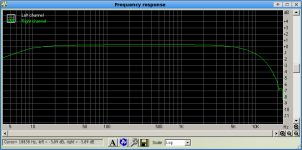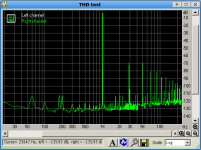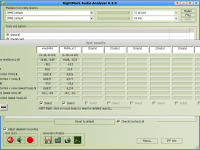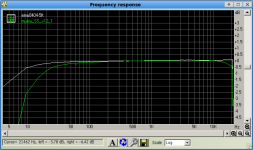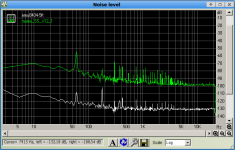ra = 5k, Ra = 680, assume gm = 6mA/V? Assume stage gain is mu. I get SRPP Zout = 1.4k, which is ra/3.6. The approximate formula gives ra/4.ruffrecords said:Not sure about the SRPP. ra at 5mA and 150V for the 6922 is about 5K for which Ra is about 680 ohms which gives Zout around 1K6 before the 0.5 factor. In my designs, there is no optimum load and the bottom cathode is bypassed. Stage gain is much larger than mu/2 so Zout is probably 800 ohms or so. Which explains why I think SRPPs have a lower output Z.
Now put the same valve in a mu-follower with Ra = 10k. Zout = 250, which is 1.5/gm.
Both circuits have approximately the same open-circuit voltage gain, a little below mu. The mu-follower has much greater current output when shorted because the 10k Ra resistor can generate much more voltage to drive the upper valve gm than the 680 of the SRPP. Of course the actual driving capability is about the same - in fact the SRPP might be better at driving current into a load as it gets a greater contribution from the lower valve. Curious therefore that almost all popular uses of the SRPP now have a high impedance load where the mu-follower would be better!
ra = 5k, Ra = 680, assume gm = 6mA/V? Assume stage gain is mu. I get SRPP Zout = 1.4k, which is ra/3.6. The approximate formula gives ra/4.
Now put the same valve in a mu-follower with Ra = 10k. Zout = 250, which is 1.5/gm.
Both circuits have approximately the same open-circuit voltage gain, a little below mu. The mu-follower has much greater current output when shorted because the 10k Ra resistor can generate much more voltage to drive the upper valve gm than the 680 of the SRPP. Of course the actual driving capability is about the same - in fact the SRPP might be better at driving current into a load as it gets a greater contribution from the lower valve. Curious therefore that almost all popular uses of the SRPP now have a high impedance load where the mu-follower would be better!
Figures seem about right. I assumed gm=5mA/V for the 6922 from the data sheet operating point. The SRPP is definitely much better at driving current into a load which is why I use them. My typical minimum load is 2400 ohms. SRPP of course has much higher distortion than mu follower so I out SRPP in NFB loop with about 20dB of NFB to bring distortion down to similar levels as mu follower (into lighter loads). Here's a link to atypical circuit:
http://www.ianbell.ukfsn.org/EzTubeMixer/docs/EzTubeMixer/EurocardCCTsht2.jpeg
CHeers
Ian
Unusual to see an SRPP used properly!
Thank you!
I've removed grid "47p" cap. I think HF improved dramatically. So it was higher capacitance. (Some issues (pf-pf) appear because of it in tranny bypass mode.)
Here are new metrics and sound.
That is a definite improvement. Still about 6dB down at 20KHz which seems a lot.
Cheers
Ian
That is a definite improvement. Still about 6dB down at 20KHz which seems a lot.
I was thinking on this all this morning. Why HF rolls off too early? Quality of parts? Oversized caps? Measurement artifacts? I keep Bass and Treble controls of soundcard to 50%. Is it correct? That is how it is when I start my system. I tried to find this info in EM-U 0404 docs but nothing is there, it looks like this is controlled solely by software and they describe only their proprietary software. I use Linux ALSA and JACK. ALSA driver sets Bass and Treble to 50% both.
When you listen the record, do you hear that it has this early HF rolloff?
So, from yours and DF96 exchange I've got that in my case Zout is somewhat 250. Is it correct? Then, should be high Zout as a possible cause of early rollof be ruled out?
I was thinking on this all this morning. Why HF rolls off too early? Quality of parts? Oversized caps? Measurement artifacts? I keep Bass and Treble controls of soundcard to 50%. Is it correct? That is how it is when I start my system. I tried to find this info in EM-U 0404 docs but nothing is there, it looks like this is controlled solely by software and they describe only their proprietary software. I use Linux ALSA and JACK. ALSA driver sets Bass and Treble to 50% both.
When you listen the record, do you hear that it has this early HF rolloff?
So, from yours and DF96 exchange I've got that in my case Zout is somewhat 250. Is it correct? Then, should be high Zout as a possible cause of early rollof be ruled out?
You should do a loop back test of youe measuring software. Jsut connect the source direct to the inputs and measure the response. SHould be completely flat.
The recording does not sound like it rolls of that much.
A high output Z would affect the bass response not the HF response.
Cheers
ian
Yes, I will. If it is not flat I'll adjust controls to make it flat, sort of calibration, then I will repeat recordings through the preamp.You should do a loop back test of youe measuring software. Jsut connect the source direct to the inputs and measure the response. SHould be completely flat.
Thanks.
And, oops, I've published only the last part with PS (1:10) input tranny configuration. It has most significant rolloff. SS (1:5) has much better FR, almost same as BP (bypass), as you can see on FR graph.The recording does not sound like it rolls of that much.
Ok. Bass does not look and sound bad, does it?A high output Z would affect the bass response not the HF response.
Thanks, Ian!
Ok. Bass does not look and sound bad, does it?
Thanks, Ian!
Bass looks 1dB down at 20Hz. Fairly respectable.
Cheers
Iab
I've made loopback test for EMU 0404 soundcard.
FR curve matches very closely with what was captured from the MuMu preamp. Conclusion - RF of the preamp is flat.
Here is sound for all input configs, and loopback test metrics.
I suggest that FR and THD of the preamp are very good. Noise level (currently 78dB) and accordingly dynamic diapason may be improved.
FR curve matches very closely with what was captured from the MuMu preamp. Conclusion - RF of the preamp is flat.
Here is sound for all input configs, and loopback test metrics.
I suggest that FR and THD of the preamp are very good. Noise level (currently 78dB) and accordingly dynamic diapason may be improved.
Attachments
I've made loopback test for EMU 0404 soundcard.
FR curve matches very closely with what was captured from the MuMu preamp. Conclusion - RF of the preamp is flat.
Here is sound for all input configs, and loopback test metrics.
I suggest that FR and THD of the preamp are very good. Noise level (currently 78dB) and accordingly dynamic diapason may be improved.
Yes, it looks like the HF response of the amp is OK. Strange that the EMU should have such a poor response in loop back test. It suggests there is either something wrong with the card or with its software set up.
Cheers
Ian
Yes, I also disappointed why my EMU shows this FR.
As described here Emu 0404 the card should have close to perfect linear FR.
Can it be because of age, wear and tear of caps, or because 5ft loopback cable?
The card itself supports quite complex equalization effects: 1 band para EQ, 1 band shelf EQ, 2,3,and 4 band EQs.
I do not know what ALSA driver uses when the Bass and Treble controls are turned on. Normally they are turned off - no equalization.
All previous recordings were made with equalization turned off.
As described here Emu 0404 the card should have close to perfect linear FR.
Can it be because of age, wear and tear of caps, or because 5ft loopback cable?
The card itself supports quite complex equalization effects: 1 band para EQ, 1 band shelf EQ, 2,3,and 4 band EQs.
I do not know what ALSA driver uses when the Bass and Treble controls are turned on. Normally they are turned off - no equalization.
All previous recordings were made with equalization turned off.
Actually, I've got the reason of poor FR. It was my loopback cable! It is Fender 5ft, new guitar cable. Most likely it has too high capacitance for input and output impedances of the emu0404 (Zi 3.3k, Zo 560).
When I plugged in 1ft cable (that is to link effect pedals), everything has been improved. FR is -0.2dB at 10Hz and +0.2 at 20kHz, SNR -97.5, THD 0.0016%.
Question. Should I use this short cables when I measure the preamp?
Its theoretical impedances are Zi=1M, Zo~=150.
Can I use 5ft cables? At least for input?
When I plugged in 1ft cable (that is to link effect pedals), everything has been improved. FR is -0.2dB at 10Hz and +0.2 at 20kHz, SNR -97.5, THD 0.0016%.
Question. Should I use this short cables when I measure the preamp?
Its theoretical impedances are Zi=1M, Zo~=150.
Can I use 5ft cables? At least for input?
I've measured metrics of MuMu preamp in different input transformer configurations and different volumes.
I think that transformer in SS configuration (1:5) with volume around 12 clicks (50%) will be most usable config.
SP (1:2.5) gives same FR and THD with a little bit more noise. PS (1:10) gives significant LF and HF rolloff and less noise.
Here are metrics and charts for E-Mu0404 and MuMu in SS with 12 click volume.
I assume MuMu metrics include according metrics of e-mu0404 card, so should be a little bit better.
But I do not know how to subtract e-mu0404 metric to get pure MuMu preamp metrics. Could you please advise?
FR 20Hz - 20kHz: +0.08dB, -0.79dB (includes +0.11dB, -0.21 dB from emu);
Noise Level: -63.2dBA (includes 98.1 from emu);
THD: 0.026% (includes 0.0018% from emu);
I think that transformer in SS configuration (1:5) with volume around 12 clicks (50%) will be most usable config.
SP (1:2.5) gives same FR and THD with a little bit more noise. PS (1:10) gives significant LF and HF rolloff and less noise.
Here are metrics and charts for E-Mu0404 and MuMu in SS with 12 click volume.
I assume MuMu metrics include according metrics of e-mu0404 card, so should be a little bit better.
But I do not know how to subtract e-mu0404 metric to get pure MuMu preamp metrics. Could you please advise?
FR 20Hz - 20kHz: +0.08dB, -0.79dB (includes +0.11dB, -0.21 dB from emu);
Noise Level: -63.2dBA (includes 98.1 from emu);
THD: 0.026% (includes 0.0018% from emu);
Attachments
Thanks Ian.
Is there a way to significantly improve noise level?
I know obvious things, first thing is that PSU should be remoted, another is to use expensive ECC83.
Sometimes I still hear some "pf-pf" noise even with input transformer. Will mains filter help?
Any other ideas? Like using more gm 12AT7 as upper tube of 1-st stage?
Or different topology?
Is there a way to significantly improve noise level?
I know obvious things, first thing is that PSU should be remoted, another is to use expensive ECC83.
Sometimes I still hear some "pf-pf" noise even with input transformer. Will mains filter help?
Any other ideas? Like using more gm 12AT7 as upper tube of 1-st stage?
Or different topology?
Thanks Ian.
Is there a way to significantly improve noise level?
I know obvious things, first thing is that PSU should be remoted, another is to use expensive ECC83.
Sometimes I still hear some "pf-pf" noise even with input transformer. Will mains filter help?
Any other ideas? Like using more gm 12AT7 as upper tube of 1-st stage?
Or different topology?
The best way to get good noise is to have a transformer as the first gain stage
It is always best to remote the PSU. Use dc heaters and elevate them to about 75V. Make sure you use suppressor capacititors across the bridge recitfiers especially on the HT supply.
Keep the connections from the input transformer secondary to the first tube as short as possible.
Once the PSU is quiet and you keep out extraneous noise, the biggest source of noise will be the first tube. You nearly always need to select these for low noise. Expensive does not mean low noise. I have measured the noise of many many tubes and they vary a lot within each type.
The ECC83 is not the lowest noise tube. The ECC88 or better still the 6922 industrial version is about 3dB quieter.
The bottom line is this. The noise from a 150 ohm source (which is what your ribbon mic looks ke to the mic pre) is about -131dBu. If your amplifier is perfect and has 70dB of gain, this noise will be amplified to -61dBu. It is impossible to do better than this. A very good semiconductor mic pre might be only 2dB noisier. A good tube mic pre is likely to be 10dB noisier. The best tube mic pre I have built so far manages to be just 7dB noisier.
Cheers
Ian
Hmm. I do not understand something. RMAA shows Noise Level: -63.2dBA for my MuMu preamp. How it relates to -61dB of noise in your example? What would be a Noise Level of the Ideal Preamp?
6922 has mu=33. Will be two stages of 6922 less noisy than one stage of 12AX7/ECC83?
6922 has mu=33. Will be two stages of 6922 less noisy than one stage of 12AX7/ECC83?
Hmm. I do not understand something. RMAA shows Noise Level: -63.2dBA for my MuMu preamp. How it relates to -61dB of noise in your example? What would be a Noise Level of the Ideal Preamp?
6922 has mu=33. Will be two stages of 6922 less noisy than one stage of 12AX7/ECC83?
dBA is a weighted measurement which always comes out better than a full bandwidtth measurement. See if you can get RMA to give you the noise level unweighted.
You also need to make an accurate measurement of your gain. I bet it is nowhere near 70dB.
The first ECC88 will be quieter than the ECC83. The noise contribution form later stages is insignificant.
Cheers
Ian
- Status
- This old topic is closed. If you want to reopen this topic, contact a moderator using the "Report Post" button.
- Home
- Amplifiers
- Tubes / Valves
- Ribbon Microphone Preamp
